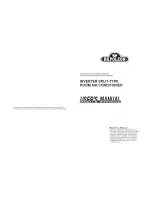
Preparation
Installer reference guide
10
RZAG71~Y1
Sky Air Alpha-series
4P573381-1 – 2019.04
If the outdoor unit is exposed to direct sea winds, install a
windbreaker.
▪ Height of windbreaker≥1.5×height of outdoor unit
▪ Mind the service space requirements when installing the
windbreaker.
a
b
c
d
c
d
a
Sea wind
b
Building
c
Outdoor unit
d
Windbreaker
Strong winds (≥18 km/h) blowing against the outdoor unit’s air outlet
causes short circuit (suction of discharge air). This may result in:
▪ deterioration of the operational capacity;
▪ frequent frost acceleration in heating operation;
▪ disruption of operation due to decrease of low pressure or
increase of high pressure;
▪ a broken fan (if a strong wind blows continuously on the fan, it
may start rotating very fast, until it breaks).
It is recommended to install a baffle plate when the air outlet is
exposed to wind.
It is recommended to install the outdoor unit with the air inlet facing
the wall and NOT directly exposed to the wind.
a
b
c
b
a
Baffle plate
b
Prevailing wind direction
c
Air outlet
5.2.2
Additional installation site requirements
of the outdoor unit in cold climates
Protect the outdoor unit against direct snowfall and take care that the
outdoor unit is NEVER snowed up.
a
b
c
c
d
a
Snow cover or shed
b
Pedestal (minimum height=150 mm)
c
Prevailing wind direction
d
Air outlet
Snow might build up and freeze between the heat exchanger and
the casing of the unit. This might decrease the operating efficiency.
For instructions on how to prevent this (after mounting of the unit),
see
"6.3.5 To provide drainage" on page 14
.
5.3
Preparing refrigerant piping
5.3.1
Refrigerant piping requirements
INFORMATION
Also read the precautions and requirements in the
"General safety precautions" chapter.
When connecting multiple indoor units to the outdoor unit, mind the
following:
Refrigerant branch kit One or more refrigerant branch kits are
required. See
"4.3.1 Possible options for the
Upward and
downward piping
Perform upward and downward piping only
on the main piping line (L1).
Branch pipes
▪ Install the branch pipes horizontally (with a
maximum inclination of 15°) or vertically.
▪ Make the length of the branch pipes to the
indoor units as short as possible.
▪ Try to keep length of the branch pipes to
the indoor units equal.
NOTICE
The piping and other pressure-containing parts shall be
suitable for refrigerant. Use phosphoric acid deoxidised
seamless copper for refrigerant.
▪ Foreign materials inside pipes (including oils for fabrication) must
be ≤30 mg/10 m.
Definitions: L1~L7, H1, H2
Pair
(a)
H1
L1
Twin
(a)
H1
H2
L1
L2
L3











































